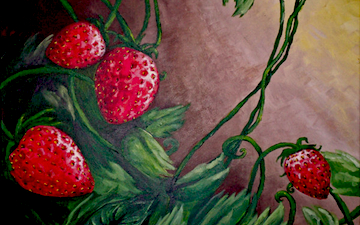The garden strawberry, Fragaria × ananassa, is a hybrid species that is cultivated worldwide for its aggregate accessory fruit, the (common) strawberry. The fruit is widely appreciated, mainly for its characteristic aroma but also for its bright red color, its juicy texture, and it is consumed in large quantities, either fresh or in prepared foods such as preserves, fruit juice, pies, ice creams, and milk shakes. Artificial strawberry aroma is also widely used in all sorts of industrialized food products.
The garden strawberry was first bred in Brittany, France, about 1740 via a cross of Fragaria virginianafrom eastern North America , which was noted for its flavor, and Fragaria chiloensis from Chile andArgentina brought by Amédée-François Frézier, which was noted for its large size.[1]
Cultivars of Fragaria × ananassa have replaced, in commercial production, the woodland strawberry, which was the first strawberry species cultivated in the early 17th century.[2]
The strawberry is, in technical terms, an aggregate accessory fruit, meaning that the fleshy part is derived not from the plant’s ovaries (achenes) but from the receptacle that holds the ovaries.[3] Each “seed” on the outside of the fruit is actually one of the ovaries of the flower, with a seed inside it. In both culinary and botanical terms, the entire thing is called a “fruit”.
Strawberry cultivars vary remarkably in size, color, flavor, shape, degree of fertility, season of ripening, liability to disease and constitution of plant.[4] Some vary in foliage, and some vary materially in the relative development of their sexual organs. In most cases the flowers appear hermaphroditic in structure, but function as either male or female.[5]
For purposes of commercial production, plants are propagated from runners (stolons) and, in general, distributed as either bare root plants or plugs. Cultivation follows one of two general models, annualplasticulture[6] or a perennial system of matted rows or mounds.[7] A small amount of strawberries are also produced in greenhouses during the off season.[8]
(From Wikipedia, January 27th, 2011)




